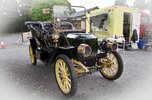Many emergency vehicles now incorporate white noise into their sirens so as we can work out which direction they are coming from - it really is amazing how well it works, our ears / hearing system is quite remarkable in its ability to work this complexity, but it does. I guess the original siren sound is to let you know its an emergency vehicle, and the white noise gives direction and speed.
And yes cyclists can here any vehicle 20mph and more very easily just from tyre noise, can even work out when the vehicles starts to slow down (which is great as that signifies they have probably seen you). The big problem with hearing on a bike is wind noise, and riding into a strong wind is not only unpleasant due to the effort required - it also removes your ability to hear vehicles approaching from behind which is quite unpleasnt, and no matter how often you look over your should someone will suddenly pass when you were not expecting it.
Yes, they went away from the old "bee-baw" sirens and over to the American style "whoop-and-wail" style sirens because the latter could be changed from "whoop" to "wail" at junctions and other points where people listening had just"zoned-out" and a sudden change usually wakes them up. The latest evolution has been to incorporate an element of white noise as well - and for exactly the reasons you state.
If it's very windy, or I'm going down a fast hill on the bike, then yes, the wind noise drowns out the noise of a following car - which is one of the reasons I said I wouldn't want cars to get any quieter.



